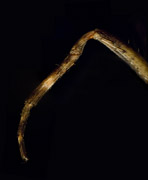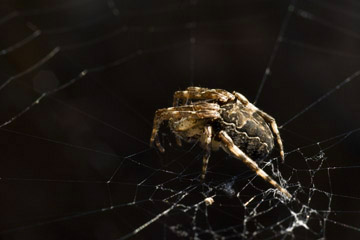






Spiders of the Irondequoit Bay
by: Jerrett McCormick
Orb-weaver spider
Class: Arachnida
Order: Araneae
Suborder: Araneomorphae
Family: Araneidae
Introduction
For those of you who are squeamish around things that lurk and crawl in the shadows, I don't think this is the article for you . . .
Because it's said that at any given time you are no more than eight feet from one of these anti-social chelicerate arthropods. In fact more than 40,000 species of spider live worldwide, and it's this diversity that has allowed these eight legged freaks to stay on top of the food chain. From the way they camoflage themselves, to how they build webs, the way they hunt, or the venom they liquify their prey with spiders are amazing. And trust me until I gave them a closer look I wasn't a fan. But eventually my fear was overshadowed by pure amazement in how they do everything. Simply put they are highly skilled predators that hold the line for keeping things like our insect population in check, making them a valuable piece of our ecosystem.
Physical Features
Spiders are opportunistic predators who use their skills of stealth, camoflage, features, and chance to capture prey several times their size. A spider's body is made of two major parts; the first known as the cephalothorax is covered by hard shell refered to as a carapace. The cephalothorax houses the eyes, mouth parts, and legs. The second major part is known as the abdomen containing most of the spiders circulatory & digestive system, as well as their three web chambers and spinneret. I'm not particularly sure of the exact species, but based on the marking on their abdomen and style of web they are a type of Orb weaver spider. The image gallery below contains several high magnification images of the Orb weaver spider and its anatomy. With a body measuring around 8-9mm end to end and legs approximately twice their body length this species is not overly large, but has been able to consume a large area in the Irondequoit Bay. The Orb weaver spider depends on its spiral shaped web and ability to sense their surroundings in order to capture small prey moving through its territory. This area along the bay is particularly windy with gusts around 15mph regularly, which made me question why such a skilled predator would chose such a poor hunting ground. After further observation I realized these spiders chose a perfect area to capture prey. Using the stones as both anchors and wind cover they have managed to position themselves in a high traffic area for small insects living along the shoreline (and some simply blown off course). I've never witnessed an area with such an abundance of spiders before, especially considering the overlapping of webs and abundance of prey caught in their webs.
Image Gallery (Click to enlarge)
 |  |  |
|---|---|---|
 |  | |
 |  |
Setup & Techniques
All of the previous images were photographed using the Nikon D200, bellows, and Zeiss objectives. The imaging system was mounted to a copy stand and the subject with small syringe, third arm, microscope stand. Fiber optics were used to light the object with a small diaphragm to control its size. With the except to the in situ images all subjects were euthanized using ethyl acetate.

Problems
I encountered nearly endless problems during the course of this project from the weather, terrain, technical issues, or the break down of my specimens. First may I say the greater Rochester area is known for its passive aggressive weather; from the constant change in temperature, rain every other day, or the amazing gusts of wind on the bay. The terrain was another serious issue because the area the Orb weaver spider chose was extremely cramped, rocky, and obviously cover in webs. And while in the studio I encountered several issues as well; such as focus, camera shake, specimen size, and color temperature. Focus and specimen size run hand in hand when you consider photographing objects only several millimeters in length will be an obvious problem, I resolved most of this problem by using a microscope stand for the ability to finely focus. Camera shake was a large issue as well mainly created from the movement of the camera mirror or the fans in the computer or fiber optics. Color temperature was another issue, because when using older fiber optics the degrees Kelvin changes proportionally based on the intensity of the light. But I think the most impressive issue I faced during the process of photographing was after too long my specimens began to dry up resulting in spiders that looked more similar to raisins than arthropods. After a week or so of brain storming I came up with the idea to use syringes to re inflate the shriveled bodies, which worked out beautifully.
Assistants
To McKinsey & Seth
Thank you for waking up early so many cold mornings to help me catch and photograph these guys.
Credit
National Wildlife Federation: FIELD GUIDE TO INSECTS AND SPIDER OF NORTH AMERICA
Wikipedia.org/spiders
Life Magazine
Contact Info:
If you found any the previous information or images interesting and would like to buy rights, prints, or discuss the subject matter or techniques in further detail contact information is list below.
jerrett.mccormick@gmail.com or jxm5591@rit.edu
or Michael Peres at mrppph@rit.edu
Return to index of articles
by students on the 'Principles and techniques of photomacrography'
course, November 2008,
Biomedical Photographic Communications (BPC)
program at the Rochester Institute of Technology (RIT).
Article hosted on Micscape Magazine (Microscopy-UK).
